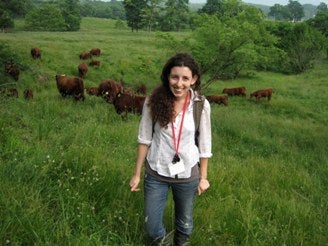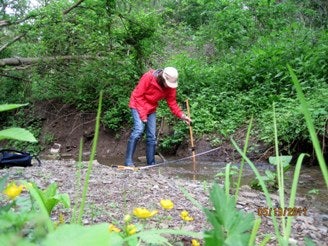Krissy Hopkins: Going with the Flow
Krissy Hopkins darts through the woods behind her parents’ house. She is on a mission. Today, she is all about catching minnows in the stream. But, on another day, it might be building a fort out of fallen logs with her sister … poking around the forest floor with sticks … or, simply, thinking.
 Why do the leaves change color?
Why do the leaves change color?
Why are there algae in the stream?
Where does the water flow to?
This natural curiosity and affinity for nature made Krissy the perfect candidate for an outdoorsy girls group sponsored by the YMCA, called Indian Princesses. As part of the program, Krissy, her sister Karen, and her dad camped, hiked, fished, and hunted for fossils, submersing themselves in the beauty of their Southwestern Pennsylvania home and building what would turn out to be a lifelong passion for Krissy.
***
It is a cool, wet May morning, and University of Pittsburgh PhD student Krissy Hopkins is out tramping around Panther Hollow again, outfitted in her favorite blue rubber boots and red jacket, her long curly brown hair tucked up under a cap and a meter stick in hand. As the Pittsburgh Parks Conservancy’s Panther Hollow research fellow for the summer of 2011, Hopkins is responsible for monitoring the health of both  Panther Hollow Run and Phipps Run streams by measuring the amount of water flowing through them.
Panther Hollow Run and Phipps Run streams by measuring the amount of water flowing through them.
The Panther Hollow Watershed comprises 384 acres, which includes part of Schenley Park, as well as the adjacent neighborhood of Squirrel Hill. At its center are Panther Hollow Run and Phipps Run, which unite just above Panther Hollow Lake. These streams no longer flow into the Monongahela River; instead they drain into Panther Hollow Lake, which then drains into a pipe that funnels stream water underground through the sewer system to the sewage treatment plant. During dry weather, the streams in Panther Hollow are disconnected from the Monongahela River. However, during wet weather, the stream water mixes with sewage and storm water in the sewer system and overflows into the Mon River. These overflows degrade local water quality in our three rivers.
“Storm water is a huge issue for Pittsburgh,” says Hopkins. “Because of the combined sewer system in Pittsburgh, storm water and sewage water share the same pipe. When we have an intense rainfall, the capacity of the pipe is exceeded, and its contents can overflow into our rivers.” Hopkins notes that right now there are over 300 places along Pittsburgh’s three rivers where sewage flows into our waterways during wet weather.
A PhD student in the Kenneth P. Dietrich School of Arts and Sciences’ Department of Geology and Planetary Science, Hopkins—on track for a 2014 graduation date—has spent much of her career examining the often complex links between humans and water resources and working to educate the public on how to protect our watersheds. She graduated from Syracuse University in 2007 with a bachelor of arts in geography and a bachelor of science in biology, with a concentration in environmental studies.
After graduation, she moved to Annapolis, Maryland, where she spent three years as a fellow with the Chesapeake Bay Program, leading outreach and education programs, including hands-on lessons about the sources of water pollution. She also served as creative manager of the Bay Backpack, an innovative on-line resource for educators interested in teaching about the Chesapeake Bay.
“There are simple things people can do in their homes or businesses to reduce their impact on our waterways,” says Hopkins. “Disconnecting downspouts from storm sewers and attaching rain barrels to downspouts to collect water, as well as simply using less water in our homes, especially when it’s raining out, will all make a difference.”
Hopkins explains that Pittsburgh, in particular, presents unique challenges. Take the city’s aging infrastructure (in some cases built 100 or more years ago) and combine it with our topography of steep slopes and gullies (such as those found in Panther Hollow), and some pretty dramatic runoff results.
“When we get a very intense rainstorm, like some of the storms we had this past August, we see the negative impact in the neighborhood of Greenfield, which is located at the bottom of the valley,” says Hopkins. “There, the capacity of combined sewer pipes can be exceeded, causing water to back up and manhole covers to pop off, shooting geysers up to 10 feet in the air. All this unbeknownst to folks stuck in rush hour traffic on the parkway bridge just 40 feet or so above the flooding.”
Hopkins points to the flooding on Washington Boulevard in Pittsburgh this past August, where four people died, due to rapidly rising flood waters. “It’s the same sort of situation as in Greenfield—it’s located in the bottom of a valley where all the combined sewer pipes converge.”
Yet Hopkins remains optimistic about involving the neighboring communities—specifically Oakland (including Pitt) and Squirrel Hill—in a solution to the problem. “Because their pipes are positioned downhill, directly toward Panther Hollow, it is largely their sewage runoff that causes problems downslope in neighborhoods like Greenfield,” she explains.
She says that, in addition to changes in the way people use water, there are also “green” infrastructure fixes, such as re-routing storm water from fast connections (such as roads and pipes) to slower connections that allow water to slowly infiltrate back into the ground (such as rain gardens and vegetated swales). Re-routing runoff from roadways can significantly reduce pollutants in streams and maintain a more consistent flow of water in streams during the summertime when flows are lower.
Already, there are several restoration efforts underway in Panther Hollow. The Pittsburgh Parks Conservancy will be installing two pilot projects in Schenley Park that address these storm water issues in spring 2012. They include placing vegetated swales along Schenley Drive and installing an infiltration trench and meadow between Bartlett and Beacon Streets.
Hopkins presented her Panther Hollow research findings, “Urban Catchment Response to Storm Water Re-routing,” at Carnegie Mellon University in early November for “The State of the Monongahela” research symposium, as well as at the 2011 Grad Expo last spring. She’ll also have the opportunity to present her work again this month in San Francisco at the American Geophysical Union’s Annual Meeting.
***
Hopkins feasts her eyes on the scenery—expansive rice fields, cattle farms, horse ranches, and greenhouses dot the landscape of open green plains, with rolling hills in the distance. She and her peers are headed off on another field trip this July morning, driving along the scenic southern coast of Hokkaido Island in Japan to visit a local cattle farm. She and the other visitors are treated to a farm tour and then a delicious open-air feast of marinated beef, sushi, pink rice, fresh cucumbers, and pumpkin custard.
As part of a group of 20 students worldwide chosen for the Hokkaido University 2011 International Summer School Program, Hopkins is relishing her week-long chance to share research results with other graduate students, learn from Japanese experts, and visit Japanese Long Term Ecological Research locations, which are ecological monitoring sites that facilitate long-term ecological studies.
Like Hopkins, everyone here is focused on the ecological impact of humans and our use of the natural resources around us. They have all performed research in their home countries and are now able to discuss each other’s work, see what is happening in Japan, and brainstorm future research projects and ways to effect positive environmental change.
By the end of their week together, they have visited two livestock farms, a fishing village, and an experimental forest. During both field trips and lectures, they discussed sustainable agriculture, biofuel production, forestry practices, fisheries, and the usage of natural resources in urban centers. In addition to sharing her own research, Hopkins also had the opportunity to facilitate a brainstorming session on the connectivity between natural areas (such as Schenley Park) and the natural resources in them that humans utilize.
It is a topic that is close to Hopkins' heart.
While she is just beginning her graduate degree at the University of Pittsburgh and is unsure exactly what the next few years will bring, she is certain of one thing.
“Success to me is a life where I constantly help people find a path towards more sustainable living,” she says.
"I want to help people see connections between the actions they take and the environment. People often get overwhelmed with all this information and feel like there is nothing they can do to have an impact. I want to help people see that small changes in our lifestyles can have a measureable impact. There are things everyone can do, no matter if they are doctors, teachers, bankers, garbage men, or housewives. We can all do something.”
For more information on the Panther Hollow Watershed, please visit www.pittsburghparks.org/pantherhollow
